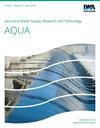Spatio-temporal evaluation of water-energy-food nexus system risk from the provincial perspective: A case study of China
IF 4.3
Q2 Environmental Science
引用次数: 0
Abstract
This study first defined the concept of the water–energy–food nexus system risk (WEF-R). Then, the WEF-R evaluation index system was established from three aspects: stability, coordination, and sustainability subsystems. Finally, the set pair analysis-variable fuzzy set model was used to evaluate the risk levels of subsystems, and the risk matrix was applied to assess provincial WEF-R levels in China from 2009 to 2018. The results showed that the stability subsystem had the greatest influence on provincial WEF-R, followed by the sustainability subsystem. The provinces with a higher risk of the stability subsystem and lower risk of the sustainability subsystem were mainly centralized in southeast coastal and central regions, which were consistent with the provinces with better socio-economic development. The provinces with lower risk of the stability subsystem and higher risk of the sustainability subsystem were mainly concentrated in northwest regions, which correspond with the provinces with better natural resources endowment but lower socio-economic development. As for the temporal evolution of risk levels, the risk levels of the coordination and sustainability subsystems showed downward trends during the study period, while the risk level of the stability subsystem displayed a small fluctuation, and the provincial WEF-R level in China presented a decreasing trend.省域视角下的水-能-粮联系系统风险时空评价——以中国为例
本研究首先定义了水-能-食物关联系统风险(WEF-R)的概念。然后,从稳定性、协调性和可持续性三个子系统构建了WEF-R评价指标体系。最后,采用集对分析-变量模糊集模型对各子系统的风险水平进行评价,并采用风险矩阵对2009 - 2018年中国各省的世界经济论坛- r水平进行评价。结果表明,稳定性子系统对省级WEF-R的影响最大,其次是可持续性子系统。稳定性子系统风险较高、可持续性子系统风险较低的省份主要集中在东南沿海和中部地区,这与经济社会发展较好的省份一致。稳定性子系统风险较低和可持续性子系统风险较高的省份主要集中在西北地区,与自然资源禀赋较好但社会经济发展较差的省份相对应。从风险水平的时间演变来看,协调和可持续性子系统的风险水平在研究期间呈下降趋势,而稳定性子系统的风险水平则呈小幅波动,中国省级WEF-R水平呈下降趋势。
本文章由计算机程序翻译,如有差异,请以英文原文为准。
求助全文
约1分钟内获得全文
求助全文
来源期刊
CiteScore
4.70
自引率
0.00%
发文量
74
审稿时长
4.5 months
期刊介绍:
Journal of Water Supply: Research and Technology - Aqua publishes peer-reviewed scientific & technical, review, and practical/ operational papers dealing with research and development in water supply technology and management, including economics, training and public relations on a national and international level.

 求助内容:
求助内容: 应助结果提醒方式:
应助结果提醒方式:


